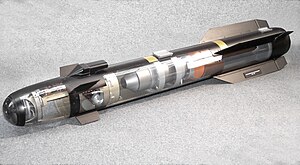AGM-114 Hellfire
| AGM-114 Hellfire | |
|---|---|

A model of a Hellfire's components
|
|
| Type | Air-to-surface and surface-to-surface missile |
| Place of origin | United States |
| Service history | |
| In service | 1984–present |
| Production history | |
| Manufacturer | Lockheed Martin, Boeing (previous second source), and Northrop Grumman (seeker only for AGM-114L Longbow Hellfire) |
| Unit cost | US$110,000 |
| Produced | 1974–present |
| Specifications | |
| Weight | 100–108 lb (45.4–49 kg) |
| Length | 64 in (163 cm) |
| Diameter | 7 in (17.8 cm) |
| Warhead |
High-explosive anti-tank (HEAT); 20 lb (9 kg) tandem anti-armor Metal augmented charge (MAC); 18 lb (8 kg) shaped charge Blast fragmentation |
|
|
|
| Engine | Solid-fuel rocket |
| Wingspan | 13 in (33 cm) |
|
Operational
range |
546 yd – 5 miles (500 m – 8 km) |
| Speed | Mach 1.3 (995 mph; 450 m/s; 1591 km/h) |
|
Guidance
system |
Semi-active laser homing millimeter wave radar seeker |
|
Launch
platform |
Rotary- and fixed-wing platforms, unmanned combat air vehicles, tripods, ships, and ground vehicles |
The AGM-114 Hellfire is an air-to-surface missile (ASM) first developed for anti-armor use, but later models were developed for precision strikes against other target types, and have been used in a number of targeted killings of high-profile individuals. It was originally developed under the name Helicopter Launched, Fire and Forget Missile, which led to the colloquial name 'Hellfire' ultimately becoming the missile's formal name. It has multi-mission, multi-target precision-strike ability, and can be launched from multiple air, sea, and ground platforms, including the Predator drone. The Hellfire missile is the primary 100-pound (45 kg) class air-to-ground precision weapon for the armed forces of the United States and many other nations.
The Hellfire can be deployed from rotary- and fixed-wing aircraft, waterborne vessels and land-based systems against a variety of targets.
Most variants are laser guided with one, AGM-114L "Longbow Hellfire", being radar guided. Laser guidance can be provided either from the launcher, such as the nose-mounted opto-electronics of the AH-64 Apache attack helicopter, other airborne target designators or from ground-based observers, the latter two options allowing the launcher to break line of sight with the target and seek cover.
The development of the Hellfire Missile System began in 1974 with the U.S. Army requirement for a "tank-buster", launched from helicopters to defeat armored fighting vehicles. Production of the AGM-114A started in 1982.
The Hellfire II, developed in the early 1990s is a modular missile system with several variants. Hellfire II's semi-active laser variants—AGM-114K high-explosive anti-tank (HEAT), AGM-114KII with external blast fragmentation sleeve, AGM-114M (blast fragmentation), and AGM-114N metal augmented charge (MAC)—achieve pinpoint accuracy by homing in on a reflected laser beam aimed at the target. Predator, Reaper and AH 665 Tiger, UCAVs carry the Hellfire II, but the most common platform is the AH-64 Apache helicopter gunship, which can carry up to 16 of the missiles at once. The AGM-114L, or Longbow Hellfire, is a fire-and-forget weapon: equipped with a millimeter wave (MMW) radar seeker, it requires no further guidance after launch—even being able to lock-on to its target after launch—and can hit its target without the launcher or other friendly unit being in line of sight of the target. It also works in adverse weather and battlefield obscurants, such as smoke and fog which can mask the position of a target or prevent a designating laser from forming a detectable reflection. Each Hellfire weighs 47 kilograms (104 lb), including the 9 kilograms (20 lb) warhead, and has a range of 8,000 metres (26,000 ft). The AGM-114R "Romeo" Hellfire II entered service in late 2012. It uses a semi-active laser homing guidance system and an integrated blast fragmentation sleeve warhead to engage targets that previously needed multiple Hellfire variants. It will replace AGM-114K, M, N, and P variants in U.S. service.
...
Wikipedia
